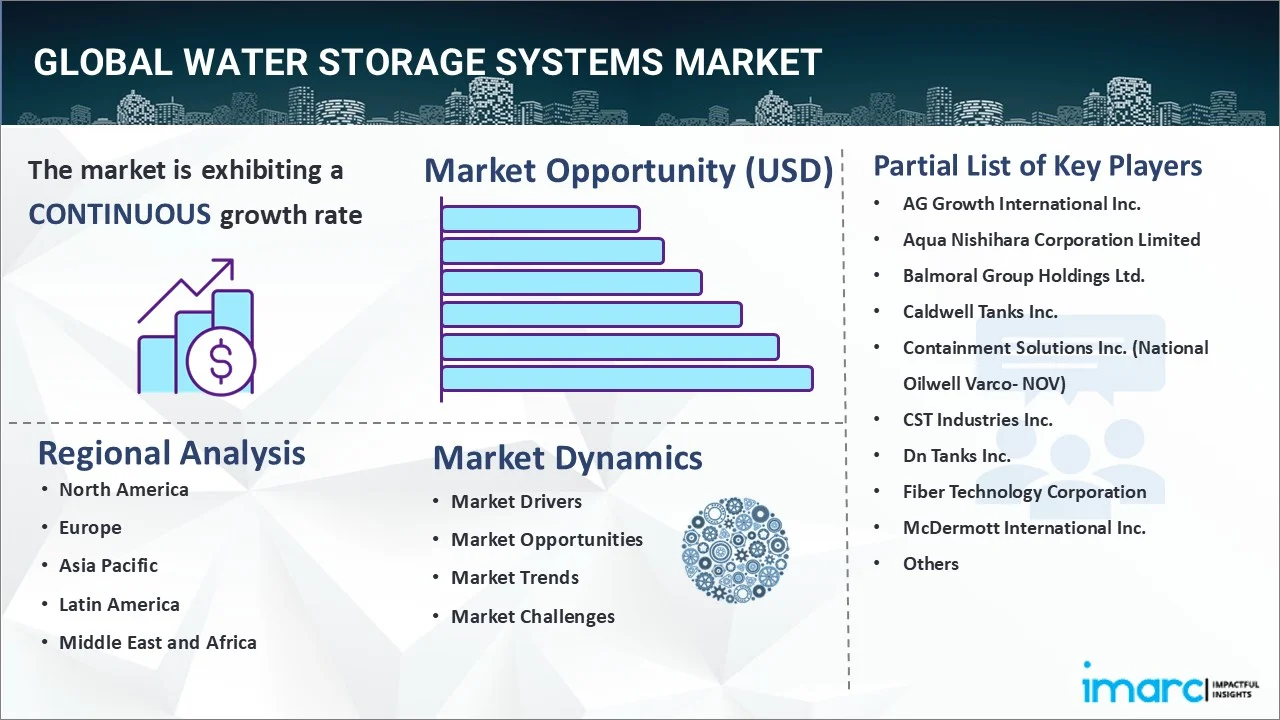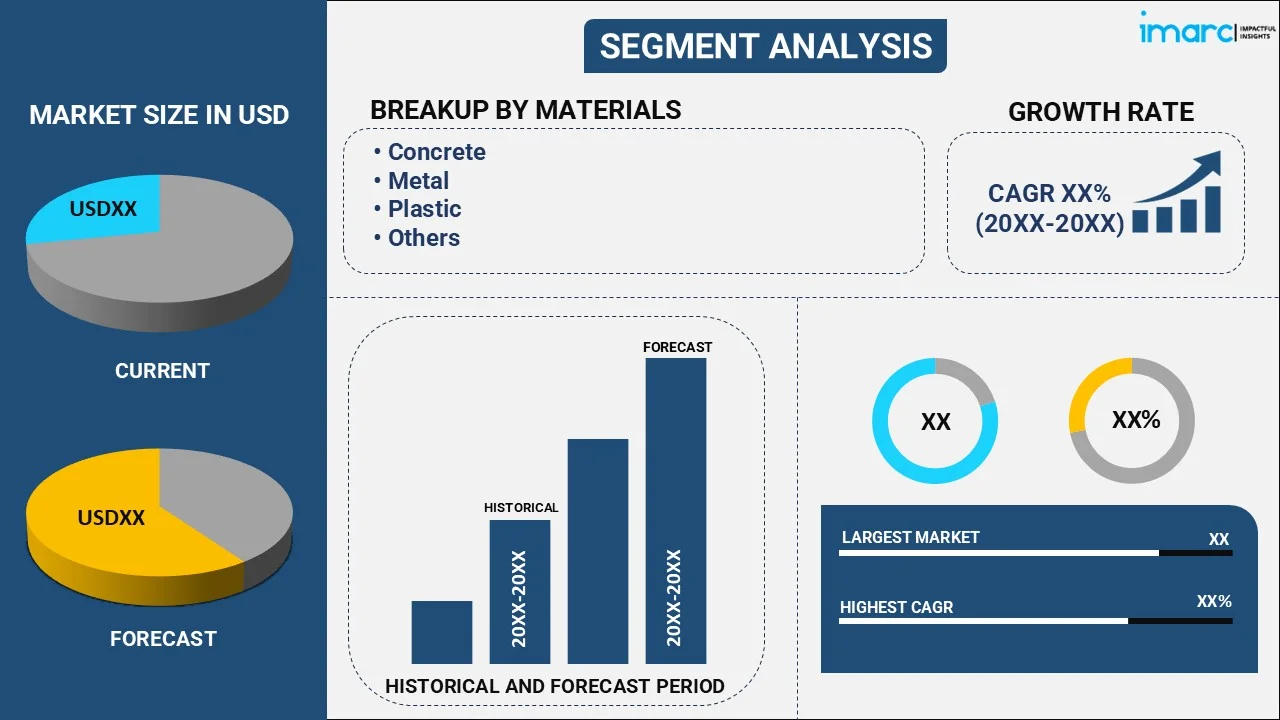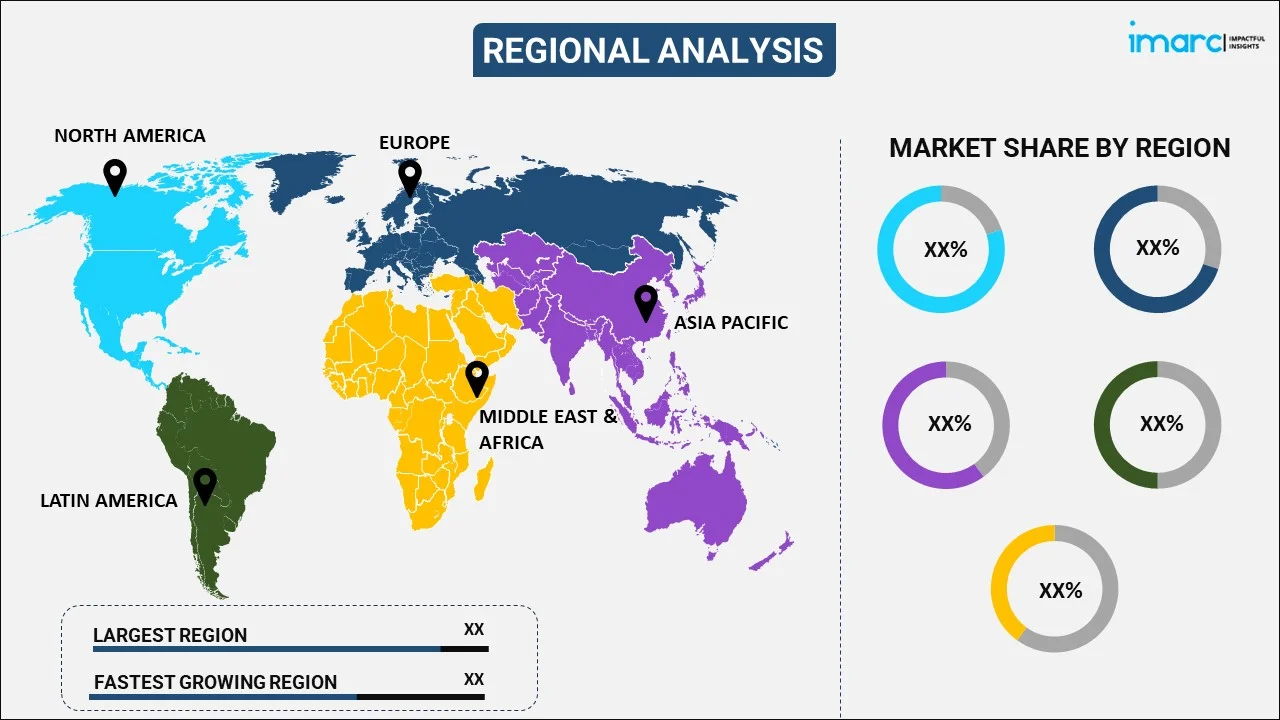
Water Storage Systems Market Report by Material (Concrete, Metal, Plastic, Fiberglass, and Others), Application (Rainwater Harvesting and Collection, Fire Suppression Reserve and Storage, Portable Water Storage Systems, On-Site Water and Wastewater Collection, Hydraulic Fracture Storage and Collection, and Others), End User (Municipal, Industrial, Commercial, Residential), and Region 2025-2033
Global Water Storage Systems Market:
The global water storage systems market size reached USD 18.7 Billion in 2024. Looking forward, IMARC Group expects the market to reach USD 35.5 Billion by 2033, exhibiting a growth rate (CAGR) of 7.42% during 2025-2033. The market is experiencing steady growth driven by increasing water scarcity, accelerated by climate change and population growth, rising government initiatives and investments in water infrastructure across various regions, and continuous technological advancements in manufacturing processes.
|
Report Attribute
|
Key Statistics
|
|---|---|
|
Base Year
|
2024
|
|
Forecast Years
|
2025-2033
|
|
Historical Years
|
2019-2024
|
|
Market Size in 2024
|
USD 18.7 Billion |
|
Market Forecast in 2033
|
USD 35.5 Billion |
| Market Growth Rate 2025-2033 | 7.42% |
Water Storage Systems Market Analysis:
- Major Market Drivers: The increasing water scarcity and a growing global population are stimulating the market's growth. The rising urbanization and the urgent need for sustainable water management solutions coupled with significant investments in both developed and developing regions are propelling the industry's demand.
- Key Market Trends: A shift towards sustainable and eco-friendly storage solutions, the adoption of rainwater harvesting systems, and the increasing use of underground storage methods are augmenting the demand for efficient water storage systems. These trends reflect the growing environmental awareness and the need for more efficient water management strategies in response to global water scarcity challenges.
- Competitive Landscape: Some of the prominent companies in the market include AG Growth International Inc., Aqua Nishihara Corporation Limited, Balmoral Group Holdings Ltd., Caldwell Tanks Inc., Containment Solutions Inc. (National Oilwell Varco- NOV), CST Industries Inc., Dn Tanks Inc., Fiber Technology Corporation, McDermott International Inc., Sintex Plastics Technology Ltd., Snyder Industries LLC, and Tank Connection L.L.C., among many others.
- Geographical Trends: According to the water storage systems market dynamics, Asia Pacific exhibits a clear dominance in the market. Rapid population growth and urbanization in countries across the region are increasing the demand for reliable water storage solutions.
- Challenges and Opportunities: The increasing water scarcity and high upfront costs for large-scale water storage systems are hampering the market growth. However, the rising urbanization, industrialization, and population growth drive demand for reliable water storage solutions.

Water Storage Systems Market Trends:
Increasing Water Scarcity and Climate Change
The global market is significantly influenced by the escalating issues of water scarcity. For instance, according to an article published by UNICEF, every year, around four billion people, or nearly two-thirds of the global population, face acute water scarcity for at least one month. By 2025, half of the world's population could be living in locations with water security. Regions experiencing prolonged droughts and erratic rainfall patterns have intensified the need for efficient water storage solutions. For instance, according to the Palmer Drought Index, about 4% of the contiguous United States was experiencing severe to extreme drought as of the end of June 2024. These factors are further contributing to the water storage systems market share.
Rising Population
The expansion of the global market is closely tied to the rapid growth of the world's population and the pace of urbanization. For instance, according to the United Nations, in mid-November 2022, the world human population surpassed 8 billion, up from an estimated 2.5 billion in 1950. The world's population is predicted to grow by about 2 billion people during the next 30 years, from 8 billion to 9.7 billion in 2050, and may peak at nearly 10.4 billion in the mid-2080s. As the global population continues to rise, so does the demand for water for domestic, agricultural, and industrial uses. These factors are further positively influencing the water storage systems market forecast.
Technological Advancements
The market is experiencing a transformation driven by technological advancements. Smart technology integration, such as IoT-based monitoring systems, helps in the efficient management and distribution of stored water. In response to this, various manufacturers are developing smart solutions for better water management. For instance, in December 2023, Energy Bots Pvt Ltd, a technology company, launched FloSens, their latest IoT solution, an automatic water level controller. This water level indicator regulates water flow into the storage tank further preventing overflows. This is further bolstering the water storage systems market revenue.
Global Water Storage Systems Industry Segmentation:
IMARC Group provides an analysis of the key trends in each segment of the market, along with forecasts at the global, regional, and country levels for 2025-2033. Our report has categorized the market based on material, application, and end user.
Breakup by Material:

- Concrete
- Metal
- Plastic
- Fiberglass
- Others
Concrete accounts for the majority of the market share
The report has provided a detailed breakup and analysis of the market based on the material. This includes concrete, metal, plastic, fiberglass, and others. According to the report, concrete represented the largest segment.
According to the water storage systems market outlook, concrete-based solutions are widely favored for their durability, strength, and relatively low cost. Concrete is predominantly used in large-scale applications such as municipal water storage, industrial water reserves, and agricultural irrigation systems. The material's ability to withstand various environmental conditions and its long lifespan make it a preferred choice for permanent and large-volume storage needs. However, the environmental impact of concrete production and potential challenges in transportation and installation are notable considerations. The ongoing development in concrete technology, including the use of reinforced and precast concrete, continues to bolster this segment's dominance in the market.
Breakup by Application:
- Rainwater Harvesting and Collection
- Fire Suppression Reserve and Storage
- Portable Water Storage Systems
- On-Site Water and Wastewater Collection
- Hydraulic Fracture Storage and Collection
- Others
Hydraulic fracture storage and collection hold the largest share in the industry
A detailed breakup and analysis of the market based on the application have also been provided in the report. This includes rainwater harvesting and collection, fire suppression reserve and storage, portable water storage systems, on-site water and wastewater collection, hydraulic fracture storage and collection, and others. According to the report, hydraulic fracture storage and collection accounted for the largest market share.
According to the water storage systems market overview, hydraulic fracture storage and collection systems are essential in the oil and gas industry, where they are used for storing water needed in the fracturing process. This segment's prominence is largely due to the global expansion of hydraulic fracturing activities, particularly in regions rich in shale gas and oil reserves. These storage systems are designed to handle large volumes of water and are often constructed from materials capable of withstanding harsh chemicals and environmental conditions. Additionally, the demand in this segment is driven by the increasing energy needs worldwide and the subsequent growth in unconventional oil and gas extraction methods.
Breakup by End User:
- Municipal
- Industrial
- Commercial
- Residential
Municipal represents the leading market segment
The report has provided a detailed breakup and analysis of the market based on the end user. This includes municipal, industrial, commercial, and residential. According to the report, municipal represented the largest segment.
As the largest segment in the market, municipal applications encompass a broad range of water storage needs for public water supply, including drinking water, emergency reserves, and fire protection. This dominance stems from the critical role of municipalities in managing water resources for large populations, especially in urban areas. The segment's growth is driven by expanding urbanization, increasing water scarcity, and the need for efficient water management systems. Municipal systems often require large-scale infrastructure, such as reservoirs and elevated tanks, and are subject to stringent regulations and standards to ensure public health and safety. For instance, in February 2024, the Ghadames Municipal Council started the building of a groundwater tank in the municipality.
Breakup by Region:

- North America
- United States
- Canada
- Asia-Pacific
- China
- Japan
- India
- South Korea
- Australia
- Indonesia
- Others
- Europe
- Germany
- France
- United Kingdom
- Italy
- Spain
- Russia
- Others
- Latin America
- Brazil
- Mexico
- Others
- Middle East and Africa
Asia Pacific leads the market, accounting for the largest water storage systems market share
The market research report has also provided a comprehensive analysis of all the major regional markets, which include North America (the United States and Canada); Asia Pacific (China, Japan, India, South Korea, Australia, Indonesia, and others); Europe (Germany, France, the United Kingdom, Italy, Spain, Russia, and others); Latin America (Brazil, Mexico, and others); and the Middle East and Africa. According to the report, Asia Pacific accounted for the largest market share.
According to the water storage systems market statistics, the Asia Pacific region holds the largest share of the global market, primarily driven by rapid urbanization, industrialization, and the growing population in countries, such as China and India. The region faces significant water scarcity challenges, compounded by climate change and pollution, which intensifies the demand for efficient water storage solutions. Governments in the Asia Pacific are increasingly investing in water infrastructure development, including large-scale urban water management and rural water conservation projects. For instance, in May 2022, the National Government of India started ambitious water projects that recognize the importance of water conservation and aim to offer tap water connections to all rural families in India. The region's diverse needs, ranging from agricultural irrigation systems to advanced urban water storage solutions, present a broad spectrum of opportunities for market growth.
Competitive Landscape:
Key players in the global market are actively engaged in a range of strategic initiatives to strengthen their market positions. These include investment in research and development to innovate and improve product offerings, particularly focusing on sustainability, durability, and efficiency. Companies are also pursuing mergers and acquisitions to expand their market reach and enhance their technological capabilities. Additionally, partnerships with governments and other organizations are common, aimed at securing contracts for large-scale infrastructure projects and contributing to regional water management initiatives. These players are also adapting to evolving regulatory environments and increasing environmental concerns by integrating eco-friendly practices and materials in their solutions. Their efforts are directed towards expanding their market presence and towards meeting the growing global demand for efficient and sustainable systems.
The market research report has provided a comprehensive analysis of the competitive landscape. Detailed profiles of all major companies have also been provided. Some of the key players in the market include:
- AG Growth International Inc.
- Aqua Nishihara Corporation Limited
- Balmoral Group Holdings Ltd.
- Caldwell Tanks Inc.
- Containment Solutions Inc. (National Oilwell Varco- NOV)
- CST Industries Inc.
- Dn Tanks Inc.
- Fiber Technology Corporation
- McDermott International Inc.
- Sintex Plastics Technology Ltd.
- Snyder Industries LLC
- Tank Connection L.L.C.
(Please note that this is only a partial list of the key players, and the complete list is provided in the report.)
Water Storage Systems Market Recent Developments:
- May 2024: PARIS launched a massive water storage basin to help clean up the river Seine, which will host marathon swimming at the Paris Games as well as the swimming part of the Olympic and Paralympic triathlons.
- April 2024: The Water and Sewerage Company Inc (WASCO) launched a water tank program to assist its customers in storing and conserving water during the dry season.
- March 2024: The Ministry of Jal Shakti launched the Jal Shakti Abhiyan, Catch the Rain-2024, to optimize rainwater harvesting and other sustainable water management practices.
Water Storage Systems Market Report Scope:
| Report Features | Details |
|---|---|
| Base Year of the Analysis | 2024 |
| Historical Period | 2019-2024 |
| Forecast Period | 2025-2033 |
| Units | Billion USD |
| Scope of the Report | Exploration of Historical Trends and Market Outlook, Industry Catalysts and Challenges, Segment-Wise Historical and Predictive Market Assessment:
|
| Materials Covered | Concrete, Metal, Plastic, Fiberglass, Others |
| Applications Covered | Rainwater Harvesting and Collection, Fire Suppression Reserve and Storage, Portable Water Storage Systems, On-Site Water and Wastewater Collection, Hydraulic Fracture Storage and Collection, Others |
| End Users Covered | Municipal, Industrial, Commercial, Residential |
| Regions Covered | Asia Pacific, Europe, North America, Latin America, Middle East and Africa |
| Countries Covered | United States, Canada, Germany, France, United Kingdom, Italy, Spain, Russia, China, Japan, India, South Korea, Australia, Indonesia, Brazil, Mexico |
| Companies Covered | AG Growth International Inc., Aqua Nishihara Corporation Limited, Balmoral Group Holdings Ltd., Caldwell Tanks Inc., Containment Solutions Inc. (National Oilwell Varco- NOV), CST Industries Inc., Dn Tanks Inc., Fiber Technology Corporation, McDermott International Inc., Sintex Plastics Technology Ltd., Snyder Industries LLC, Tank Connection L.L.C, etc. |
| Customization Scope | 10% Free Customization |
| Post-Sale Analyst Support | 10-12 Weeks |
| Delivery Format | PDF and Excel through Email (We can also provide the editable version of the report in PPT/Word format on special request) |
Key Questions Answered in This Report:
- How has the global water storage systems market performed so far, and how will it perform in the coming years?
- What are the drivers, restraints, and opportunities in the global water storage systems market?
- What is the impact of each driver, restraint, and opportunity on the global water storage systems market?
- What are the key regional markets?
- Which countries represent the most attractive water storage systems market?
- What is the breakup of the market based on the material?
- Which is the most attractive material in the water storage systems market?
- What is the breakup of the market based on the application?
- Which is the most attractive application in the water storage systems market?
- What is the breakup of the market based on the end user?
- Which is the most attractive end user in the water storage systems market?
- What is the competitive structure of the market?
- Who are the key players/companies in the global water storage systems market?
Key Benefits for Stakeholders:
- IMARC's report offers a comprehensive quantitative analysis of various market segments, historical and current market trends, market forecasts, and dynamics of the water storage systems market from 2019-2033.
- The research study provides the latest information on the market drivers, challenges, and opportunities in the global water storage systems market.
- The study maps the leading, as well as the fastest-growing, regional markets. It further enables stakeholders to identify the key country-level markets within each region.
- Porter's five forces analysis assists stakeholders in assessing the impact of new entrants, competitive rivalry, supplier power, buyer power, and the threat of substitution. It helps stakeholders to analyze the level of competition within the water storage systems industry and its attractiveness.
- The competitive landscape allows stakeholders to understand their competitive environment and provides insight into the current positions of key players in the market.
Need more help?
- Speak to our experienced analysts for insights on the current market scenarios.
- Include additional segments and countries to customize the report as per your requirement.
- Gain an unparalleled competitive advantage in your domain by understanding how to utilize the report and positively impacting your operations and revenue.
- For further assistance, please connect with our analysts.
 Request Customization
Request Customization
 Speak to an Analyst
Speak to an Analyst
 Request Brochure
Request Brochure
 Inquire Before Buying
Inquire Before Buying




.webp)




.webp)












